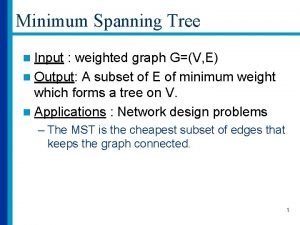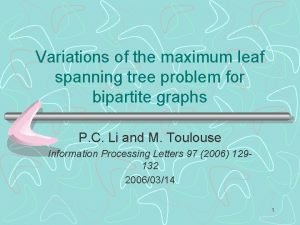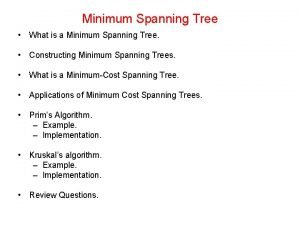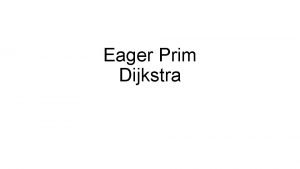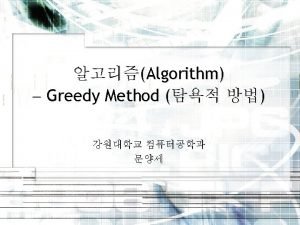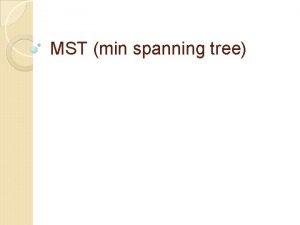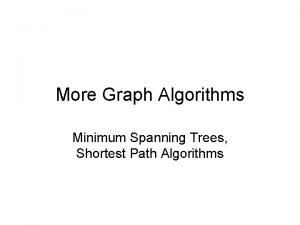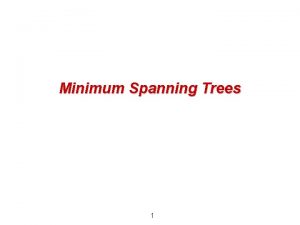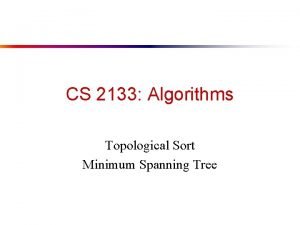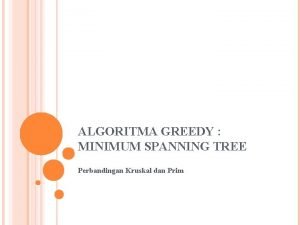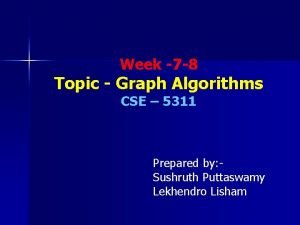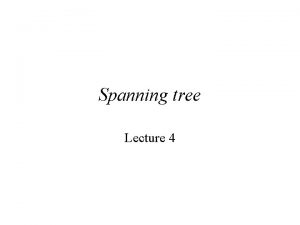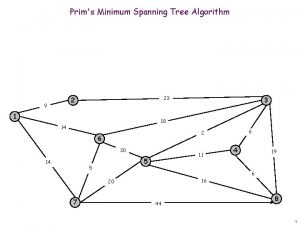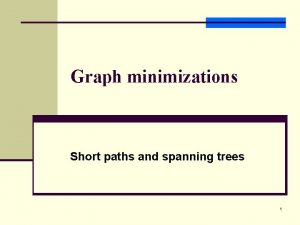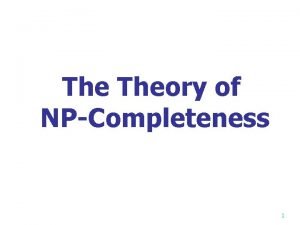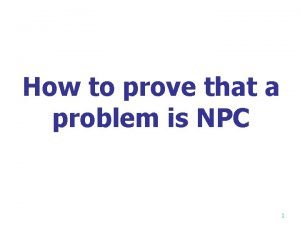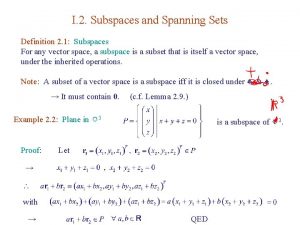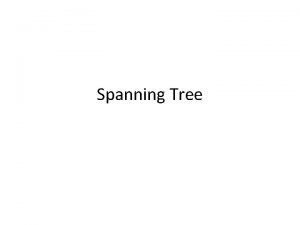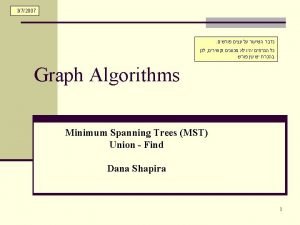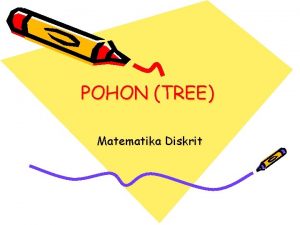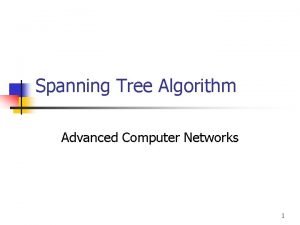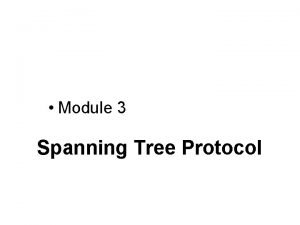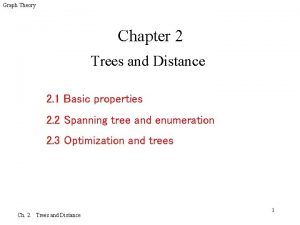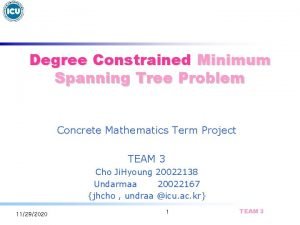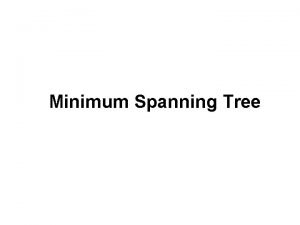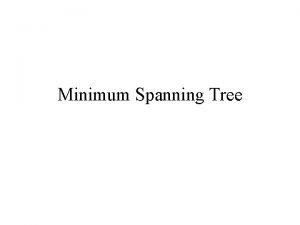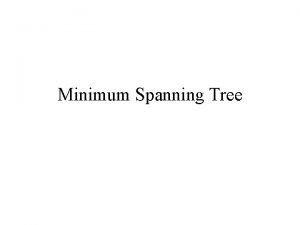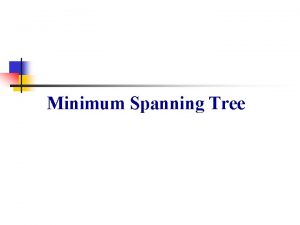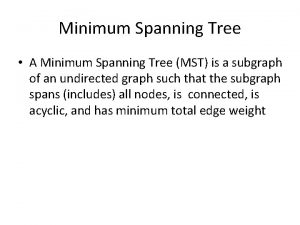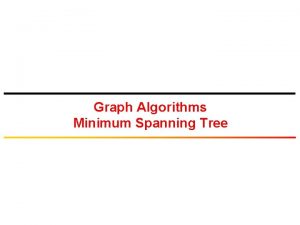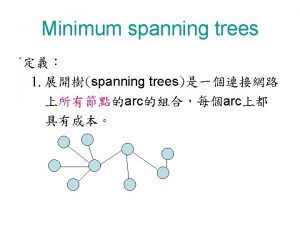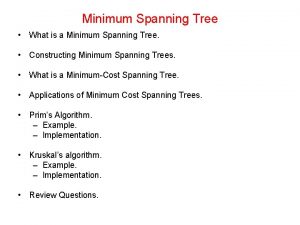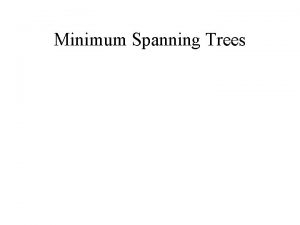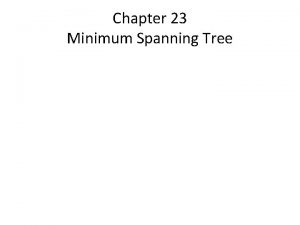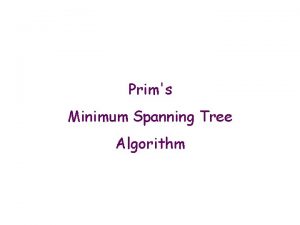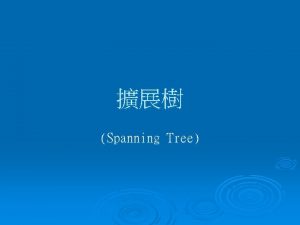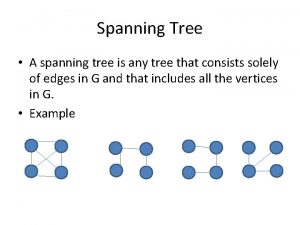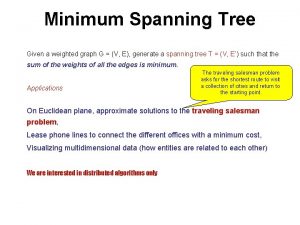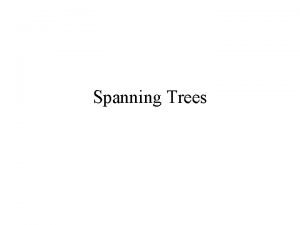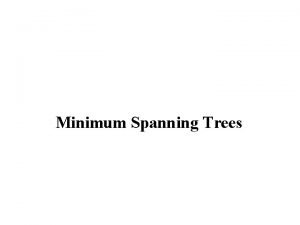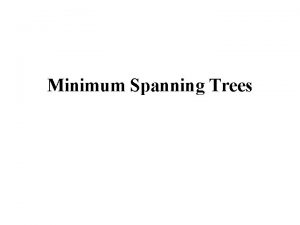Minimum Spanning Tree Given a graph G V





























- Slides: 29



- עץ פורש מינימלי Minimum Spanning Tree Given a graph G = (V, E) and an assignment of weights w(e) to the edges of G, a minimum spanning tree T of G is a spanning tree with minimum total edge weight הוא עץ פורש שסכום המשקולות על הצלעות שלו הוא מינימלי (MST) 1 3 3 6 6 9 7 8 1 3 2 7 5 4 3




A Cut Theorem: Let A be a subset of the edges of some minimum spanning tree of G; let (X, Y) be a cut that respects A; and let e be a minimum weight edge that crosses (X, Y). Then A {e} is also a subset of the edges of a minimum spanning tree of G; edge e is safe. 12 4 9 7

A Cut Theorem u e v f T w(e) ≤ w(f) w(T') ≤ w(T) 8

Proof: n Let T be a MST such that A T. n If e = (u, v) T, add e to T. n The edge e = (u, v) forms a cycle with edges on the path p from u to v in T. Since u and v are on opposite sides of the cut, there is at least one edge f = (x, y) in T on the path p that also crosses the cut. n f A since the cut respects A. Since f is on the unique path from u to v in T, removing it breaks T into two components. n w(e) ≤ w(f) (why? ) n Let T ' = T – {f} {e} w(T ') ≤ w(T). 9

A Cut Theorem Corollary: Let G=(V, E) be a connected undirected graph and A a subset of E included in a minimum spanning tree T for G, and let C=(VC, EC) be a tree in the forest GA=(V, A). If e is a light edge connecting C to some other component in GA, then e is safe for A. Proof: The cut (VC, V–VC) respects A, and e is a light edge for this cut. Therefore, e is safe. 10


Correctness Proof ei Sorted edge sequence: e 1, e 2, e 3, e 4, e 5, e 6, …, ei + 1, ei + 2, ei + 3, …, en Every edge ej that cross the cut have a weight w(ej) ≥ w(ei). Hence, edge ei is safe. 12

קודקודים שייכים לאותו רכיב 2 כדי לדעת אם union-find נעזר במבנה הנתונים , קשירות Union-Find Data Structures n. Given a set S of n elements, maintain a partition of S into subsets S 1, S 2, …, Sk n. Support the following operations: n. Union(x, y): Replace sets Si and Sj such that x Si and y Sj with Si Sj in the current partition n. Find(x): Returns a member r(Si) of the set Si that contains x n. In particular, Find(x) and Find(y) return the same element if and only if x and y belong to the same set. n. It is possible to create a data structure that supports the above operations in O(α(n)) amortized time, where α is the inverse תחזיר α(n) הערכים מאוד קטנים לכן Ackermann function. 5 מקסימום 13

Kruskal’s Algorithm Using Union. Find Data Structure Kruskal(G, w) A for each vertex v V do Make-Set(v) sort the edges in E in non-decreasing weight order w for each edge (u, v) E do if Find-Set(u) ≠ Find-Set(v) then A A {(u, v)} Union(u, v) return A 14

Kruskal’s Algorithm Using Union. Find Data Structure בהנחה שאנו יודעים לממש את ? מהו זמן הריצה שלו , האלגוריתם זמן מינימלי למיון קשתות n. Analysis: n. O(|E| log |E|) time for everything except the operations on S n. Cost of operations on S: n. O(α(|E|, |V|)) amortized time per operation on S n|V| – 1 Union operations n|E| Find operations סה"כ לאחר מיון הקשתות לא n. Total: O((|V| + |E|)α(|E|, |V|)) running time כולל מתנהגת α - כיון ש n. Total running time: O(|E| lg |E|). כמעט כמו קבוע : נקבל שבסה"כ 15

Union/Find נסתכל על הפעולות על מבנה הנתונים ונבין מה זמן הריצה שלהן n Assumptions: The Sets are disjoint. n Each set is identified by a representative of the set. n Initial state: n A union/find structure begins with n elements, each considered to be a one element set. n Functions: תומך בפעולות n Make-Set(x): Creates a new set with element x in it. n Union(x, y): Make one set out of the sets containing x and y. n Find-Set(x): Returns a pointer to the representative of the set מחזירים נציג של containing x. הקבוצה n 16

Basic Notation n The elements in the structure will be numbered 0 to n-1 n Each set will be referred to by the number of one of the element it contains נמספר את n Initially we have sets S , …, S 0 1 n-1 האיברים n If we were to call Union(S 2, S 4), these sets would be removed from the list, and the new set would now be called either S 2 or S 4 נסמן n Notations: n n Make-Set operations n m total operations n n m עברנו לקבוצות כי הרעיון הזה עוזר לפתור עוד בעיות מלבד זו שראינו בשיעור הקודם 17


מה יהיה זמן הריצה במצב ? זה Analysis n The worst-case analysis: n n Find(i) takes O(1) time Union(Si, Sj) takes (n) time עוברים על כל איברי המערך n A sequence of n Unions will take (n 2) time לוקחים סדרה כדי לקבל סיבוכיות לשיעורין 19


מה יהיה זמן הריצה במצב ? זה Analysis n The worst-case analysis: n n n Find(i) takes O(1) time Make-Set(i) takes O(1) time Union(Si, Sj) takes (n) time (Why? ) n/2 כי צריך לעבור בממוצע על איברים n A sequence of n Unions-Find will take (n 2) time (Example? ). פעולות n עשינו . union-find של Θ(n 2) פעולות שלוקחות סה"כ O(n) עכשיו Make-set : נבצע את פעולות האיחוד עד הסוף union(x 2, x 1) n-1 union(x 3, x 2) פעולות … union(xn, xn-1) n*O(1) + (n-1) Θ(n) =( O(n) + O(n 2) ) / 2 = Θ(n 2) Make-set union נחלק במס' הפעולות : זמן הריצה לשיעורין 21

מבנה נתונים נוסף שאולי יעזור לנו כי עדיין לא השגנו זמן ריצה טוב הוא עץ שבו כל שורש הוא הנציג של הקבוצה Up-Trees n A simple data structure for implementing disjoint sets is the up- tree. n We visualize each element as a node n A set will be visualized as a directed tree n Arrows will point from child to parent n The set will be referred to by its root H A X W H, A and W belong to the same set. H is the representative B F R X, B, R and F are in the same set. X is the representative 22

Operations in Up-Trees נראה את הפעולות על העץ Follow pointer to representative element. find(x) { האב של -P(x) x if (x≠p(x)) // not the representative then p(x) find(p(x)); return p(x); } 23

Union n Union is more complicated. n Make one representative element point to the other, but which way? Does it matter? 24


A worst case for Union can be done in O(1), but may cause find to become O(n) A B C D E Consider the result of the following sequence of operations: Union (A, B) Union (C, A) Union (D, C) Union (E, D) E : נקבל עץ מנוון D C B A וזה לא עזר לנו לגבי זמן הריצה 26

נבחן ייצוג של עץ הפוך באמצעות מערך Array Representation of Up-tree n Assume each element is associated with an integer i=0…n-1. From now on, we deal only with i. n Create an integer array, A[n] n An array entry is the element’s parent n A -1 entry signifies that element i is the representative element. במקום של הנציג נשים. כל איבר נמצא במקום שלו . -1 27

? איך מתבצעות הפעולות בייצוג הזה Array Representation of Up-tree Now the union algorithm might be: Union(x, y) { A[y] = x; // attaches y to x } The find algorithm would be find(x) { if (A[x] < 0) הגענו לשורש return(x); נחפש את מי else שנמצא באותו בתא ) מקום במערך return(find(A[x])); שמור האינדקס של ( האבא } Performance: ? ? ? דוגמא למימוש יש בהמשך 28

Analysis מה יהיה זמן הריצה במצב ? זה n Worst case: Union(Si, Sj) take O(1) time נשים לב שעדיין לא השגנו זמן ריצה טוב n Find(i) takes O(n) time n Can we do better in an amortized analysis? n What is the maximum amount of time n operations could take us? n Suppose we perform n/2 unions followed by n/2 finds n The n/2 unions could give us one tree of height n/2 -1 2 n Thus the total time would be n/2 + (n/2) = O(n ) n This strategy doesn’t really help… n 29
 Minimum spanning tree weighted graph
Minimum spanning tree weighted graph Minimum leaf spanning tree
Minimum leaf spanning tree Minimum cost spanning tree
Minimum cost spanning tree Dijkstra vs prim vs kruskal
Dijkstra vs prim vs kruskal Minimum spanning tree 알고리즘
Minimum spanning tree 알고리즘 Minimum spanning tree definition
Minimum spanning tree definition Minimum spanning tree shortest path
Minimum spanning tree shortest path Minimum spanning tree
Minimum spanning tree Minimum spanning tree
Minimum spanning tree Minimum spanning tree
Minimum spanning tree Minimum spanning tree
Minimum spanning tree Minimum spanning tree
Minimum spanning tree Prims
Prims Minimum spanning tree
Minimum spanning tree Spanning tree of a graph
Spanning tree of a graph Spanning tree of a graph
Spanning tree of a graph Minimum spanning set
Minimum spanning set Common spanning tree
Common spanning tree Spanning tree definition
Spanning tree definition Spanning tree
Spanning tree Tree matematika diskrit
Tree matematika diskrit Protocolo spanning tree
Protocolo spanning tree Cisco spanning tree best practices
Cisco spanning tree best practices Spanning tree algorithm in computer networks
Spanning tree algorithm in computer networks Adalah
Adalah Spanning-tree bpdu-protection
Spanning-tree bpdu-protection Root path cost berechnen
Root path cost berechnen Csc longin
Csc longin Forest in graph theory
Forest in graph theory Degree constrained spanning tree
Degree constrained spanning tree
